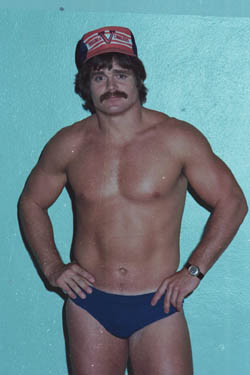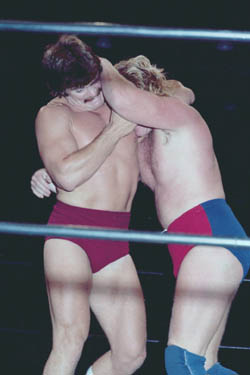
Steve Travis in Florida. Photo courtesy Pete Lederberg, facebook.com/PeteLederbergsWrestlingPhotos
When he learned that Chris Benoit murdered his wife and seven-year-old son in late June before taking his own life, ex-wrestler Steve Musulin, was, like most people, sick to his stomach.
When he learned that Benoit had stockpiled months worth of anabolic steroids, and that other WWE wrestlers routinely relied on an Internet pharmacy as their ‘roid provider of choice, Musulin just shook his head sadly.
Twenty-five years later. More drugs. More health problems. More deaths. More of the same.
“When I was wrestling, just a random guess, I would say 50 percent of the wrestlers were doing drugs of some type. Maybe 30 percent were doing steroids and the ones who did them, you could look at them and tell,” said Musulin, whose pro career stretched from 1976 to 1984.
“And nothing’s changed. Guys die from it. They died from it back then; they’re still dying from it now. It looks like the stakes might be a little bigger now because of sex, drugs and rock and roll, but it’s all in pursuit of being successful in your chosen business.”
Musulin has a better perspective than most on the long-term consequences of steroid and drug abuse. As Steve Travis, he wrestled with a fair degree success of the WWWF in the late 1970s and early 1980s, where he was exposed to a rampant drug scene. His friend and tag team partner, Rick “Quick Draw” McGraw, was just 30 when died in 1985 of heart failure brought on by drug use.
In 1991, Musulin was subpoenaed in the highly publicized steroid trial of Dr. George Zahorian, the first time wrestling’s pharmaceutical fixation dragged the business through mud. And his career ended because of a horrific car accident in 1984 that he attributes to his involvement in the business’ drug culture.
“You kind of get wrapped up in that Hollywood show biz kind of thing when you start tasting success. That’s definitely what happened to me when I went to WWF and certainly started making more money,” Musulin said in a matter-of-fact tone.

Steve Travis in action. Photo courtesy Pete Lederberg, facebook.com/PeteLederbergsWrestlingPhotos
“I was making $1,500-$2,000 a week up there and I started pumping heavy iron with McGraw and we started having success as a tag team. It just kind of grew with you and before you knew it, you’re taking uppers to make the long trips. You’re taking downers to get to sleep at 3 a.m. because you’ve got to get up and do it all over again the next day and you’ve got to get to the gym and get big, and you’ve got to take juice to do that. And you’d be surprised at how quickly and easy it is to fall in that pattern if you’re running with a crowd that’s doing the same thing. It’s hard to be objective about it.”
Though well removed from today’s wrestling scene, Musulin’s reflections about the dawn of the wrestling-drug connection are hauntingly familiar at a time when big-name stars like Bret Hart admit to past steroid use and the names of current wrestlers repeatedly pop up in ongoing criminal investigations.
Musulin first encountered steroids, notably Dianabol, in small legal doses as an offensive lineman for Guilford College football team in North Carolina in the mid-1970s, more than a decade before the federal government regulated them as controlled substances.
He makes one thing clear — accompanied by laborious training, steroids do the trick. As a freshman, he ran a the 40-yard dash in 5.1 seconds and weighed 220 pounds, As a senior, he ran a 4.9-40 at 260 pounds, and made two All-American teams.
“If you weren’t as blessed physically as some others, it allowed you to pursue it more passionately and you had your destiny in your hands,” he said. “You could do in two years what it would take you six or seven years to do without, and you could do it better.”
Based on his experience and observations, Musulin doubts from a distance that steroids played any role in the Benoit murders. “As I’ve told a lot of people who asked me, steroids might make you want to slap your momma, but they won’t make you want to kill her,” he said. “You get mad but you don’t get psychotic. At least I’ve never known anyone who has.”
But he is just as unambiguous about their health implications, not to mention the immoral competitive advantage they provide to users.
“People don’t understand how steroids use and how, when you mix different types of recreational drugs and you’ve got a baseline of steroids in your system, that they just all don’t blend well,” he said.
“They speed up your system and I think they all, working together, have an adverse effect on your system. Because they’re in a physical environment working out, wrestling, people don’t think they could have bad tickers or their arteries could be getting clogged up. But you’re messing with the timing of your body. You’re not having regular checkups or anything else, which explains why these guys are dying in their late 20s and 30s and so forth.”
As a senior at Guilford, Musulin lived in the same apartment complex as Johnny Powers, a worldwide star who was trying, unsuccessfully, to salvage the remnants of the International Wrestling Association. Under Powers’ tutelage, Musulin became Stonewall Jackson, working the IWA and then the Canadian Maritimes during the summer of 1977, when he captured the Canadian title.
He wrestled under his real name, which had some football-crossover appeal in the Carolinas, for Jim Crockett Promotions, until he got the call to the big stage in late 1978. With Jimmy Valiant suffering from hepatitis, WWF promoter Vincent J. McMahon summoned Musulin to New York as Stevie Valiant, the youngest member of the Valiant brothers crew, promising him the tag team title.
“The last week I was in for Crockett, I went and had my hair dyed blond and spent about 500 bucks on all this gaudy material, garments and stuff,” he said with a chuckle. But about a week before he headed for the Big Apple, McMahon reshuffled the deck, bringing Jimmy back in the picture and assigning Musulin to a middle-of-the-card role as a fan favorite as Steve Travis.
Steve Musulin. Photo courtesy Peggy Lathan
Still, it was still a decent gig, one that earned him billing as the federation’s Rookie of the Year. He stayed with the WWWF for about a year and reprised the role in 1981 and 1982 with McGraw as the “Carolina Connection.” For the most part, McMahon, the father of today’s WWE chairman, protected him against ignominy of a loss on TV, and turned to him in Madison Square Garden as fodder for the bad guy du jour, such as Blackjack Mulligan.
The lifestyle was another matter, though. Musulin was in the thick of it as Zahorian dispensed all manner of drugs to wrestlers as attending ringside physician at TV tapings in Allentown, Pa., and Hershey, Pa. In the early ’80s, steroids existed in a legal gray area — they weren’t criminalized until a 1988 law that eventually tripped up Zahorian.
“Guys would come out of there with big brown paper sacks of various things. That’s like going to a candy shop,” Musulin said. “Guys would bring in a handful of cash and leave out of there with all kinds of uppers and downers and pain pills and injectible steroids, oral steroids, testosterone. Everybody would kind of research it on their own and come up with their own ideas.”
In fact, he couldn’t believe his eyes when he first spotted McGraw. “He was 5-8, weighed 240 and he had one of the biggest necks I’d ever seen on someone. He’d been up there taking steroids and pumping the heavy iron. We started working out immediately. I got into the swing of thing because he introduced me to the doc who gave out all of that stuff.”
Musulin was unique among his compatriots because he took a different stance when Zahorian went on trial in 1991 for illegally peddling steroids to Hulk Hogan, Vincent K. McMahon, Roddy Piper and others. To him, wrestlers should have been, to some degree, culpable for their actions. But after two days of sitting outside the courtroom, he never took the stand. Zahorian was later sentenced to 36 months in jail.
“The doc knew very well what was going on. He wanted that damn money so bad. He might leave out of there on TV days with four to five grand in cash because he’d bring a lot of stuff and leave out of there with brown paper sacks. I’d seen it happen many times,” Musulin said.
Steve Musulin. Photo courtesy Peggy Lathan
“But I tried to be defensive of the doc to a degree because I used myself as an example. I said, ‘I knew what I was getting myself into … I don’t think it’s right everybody is trying to shovel stuff on him even though he might be guilty of some things.’ ”
While Musulin viewed steroids and drug use as common in all wrestling territories, they clearly were more prevalent in the Northeast. “I would attribute that to more pressure, more of the young gun-type guys that were looking to make it big. And obviously TV is a big part of it and you have to look the role in order to get the role,” he said.
But while he believes wrestlers need to shoulder responsibility for their actions, Musulin also feels the WWF has been operating for years with a meaningless “don’t ask, don’t tell” policy, not unlike the U.S. military’s standard on gay enlistees.
“Vince never came out that I’m aware of and told anybody to take steroids. It was something you wanted to do,” he said, quickly adding that the front office was well aware of the out-of-control drug use and effectively condoned it.
“Officially, from the office, no one ever came in the locker room and said, ‘OK, I don’t want anybody taking steroids. It’s not good for you. Guys are screwing up.’ There was never any guidance for or against. I never heard one thing. This was before the drug testing ever got going.”
In part, he thinks that attitude came from the top of the company. Musulin said he was amazed at the younger McMahon’s apparent fascination with bulging biceps during TV interviews when the elder McMahon was still running the show.
“I don’t know what his issue is, but he’s always had this thing about being big because he bought his suits two sizes too big. You ever notice how he wears big suits, you know, has them tailor-made to where they’re tapered down and the shoulders are padded so much you could wear them on a football field,” he said.
“I remember looking at him when we did interviews in Allentown, I would see how his suits were too big for him and I just thought, well, he maybe wants to be bigger or something. But I think it went a lot deeper than that.”
Interestingly, Musulin eventually concluded that looks weren’t the be-all and end-all in entertaining fans and drawing money, tracing that lesson to a match with former NWA champion Dory Funk Jr. in Fayetteville, N.C.
Funk would never be confused with a ripped Greek Adonis, and Musulin was unenthusiastic about the contest, which was scheduled for about 25 minutes. “We got out there and he said, ‘You just listen to me. We’re not going to do anything but work a headlock the whole match.’ I said ‘What?’ I was ready to do some flying around and everything. We worked the whole match with a headlock and by the end of the match the crowd was really involved in it. He really showed me that what you do and when you do it in the ring is more important than how you looked.”
By the mid-1980s, the bell had started to toll on prominent names in the drug-addled sport. McGraw’s death at such a young age was stunning. So was the 1985 passing of Jay Youngblood, whom Musulin knew in the Carolinas. Ricky Steamboat, Youngblood’s tag team partner, has described his friend’s sad demise, and Musulin’s eyewitness report serves as confirmation.
Steve Musulin at work on a junkyard sculpture.
“He was a classic example of misusing steroids because he was one of the few guys I knew that took steroids and never worked out. You absolutely have to work out if the steroids are going to work for you. But who knows what he was thinking? He never worked out. He took steroids and all the other drugs,” Musulin said.
Musulin’s drug use came to haunt him in 1984 after he blacked out behind the wheel in Georgia, leading to a car crash that killed another motorist and left him with a permanent spinal injury. Though doctors feared he’d be confined to a wheelchair, he worked doggedly at his rehabilitation and now uses a cane to walk. Briefly incarcerated for vehicular homicide, he’s long since moved on.
He just marked his 23rd anniversary with ACAC Fitness and Wellness in his hometown of Charlottesville, Va., one of the mid-Atlantic’s largest health facilities, and he has spoken to groups about the dangers of drug abuse. His athletic prowess came full circle in 2004, when Guilford inducted him into its sports Hall of Fame.
He’s also carved out a neat side career as a specialist in recycled art, using his welding skills to design one-of-a-kind pieces like dogs and roosters from old tools and scrap metal that otherwise were headed for the local landfill.
One of Steve Musulin’s junkyard sculptures.
As to today’s wrestling, he thinks putting teeth in a couple of major state athletic commissions by requiring random drug tests of wrestlers — and suspending violators — could do a world of good. “Anything that shows the negativity of what’s going on, the immorality of it, would help.”
There’s no bitterness in his voice as he looks back at his time in the business, but there is a touch of melancholy when he considers that too few people have learned lessons from wrestling’s laundry list of tragedies.
“You think those guys have all stopped taken steroids?” he asked. “They haven’t stopped because of the Benoit thing, just like no one stopped because of the ‘Quick Draw’ thing. It’s a shortcut to making it on top and there’s so much pressure … I’m afraid we’ve just got the tip of the iceberg.”
RELATED LINK
